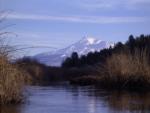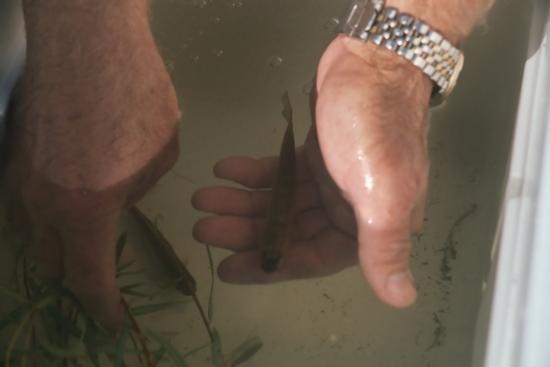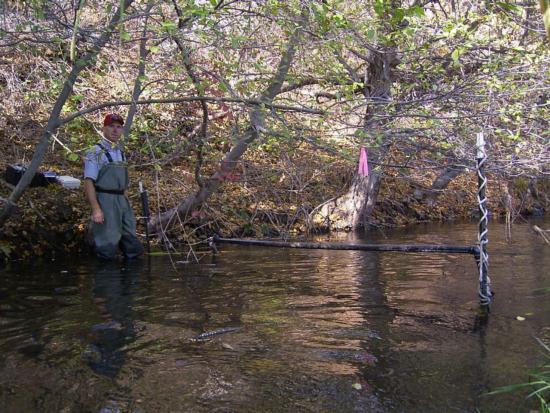Conservation of Shasta River Coho Salmon
-
IssueCoho salmon (Oncorhynchus kisutch) in the Shasta River are part of the federal Southern Oregon/Northern California evolutionary significant unit (SONC ESU) and are listed as threatened. At the state level coho salmon in the Shasta River are part of the Northern California designation, and are also listed as threatened. There are multiple factors that may limit salmonid populations in the watershed, including water quantity, water quality, riparian dysfunction, excessive sediment yield, spawning requirements, and rearing requirements.

-
Objectives
The purpose of this study was to monitor juvenile coho salmon distribution, movement, and habitat use in the Shasta River in order to identify and quantify linkages between coho salmon and factors such as stream and riparian habitat, temperature, dissolved oxygen, water quality, macro-invertebrates, and agricultural practices. This study also aimed to help to determine locations of rearing of coho salmon in the Shasta River, which are currently not known. The study also aimed to assist in determining and establishing conditions suitable for coho salmon recovery in the Shasta River.
A key objective of the study was to capture and tag juvenile coho salmon with passive integrated transponder (PIT) tags. It would then be possible to monitor coho salmon distribution and movement using PIT antenna arrays strategically located along the Shasta River between Dwinnell Reservoir and the confluence with the Klamath River.
-
Research Activities
Between 8 June 2004 and 14 December 2004 minnow trapping and PIT tagging were conducted in five reaches of the river between Parks Creek and the Klamath River confluence.
-
Results
In 2004 no coho salmon were captured in any of the sample reaches. During this time a total of 83 juvenile rainbow trout/steelhead (Oncorhynchus mykiss) were captured, and 67 of these were PIT tagged. In 2005 sampling efforts were focused on the canyon section of the river, to which radio tagged coho salmon spawners were tracked by CDFG in winter 2004-05. Between 16 February 2005 and 17 June 2005 a total of 40 juvenile coho salmon were caught, of which 11 were large enough to be PIT tagged. One juvenile rainbow trout/steelhead was also caught and PIT tagged. A PIT antenna was operated in a side channel of the canyon to detect any PIT tagged fish that passed by the antenna.
Minnow traps baited with salmon roe have proven to be an effective and low impact method of capturing both juvenile rainbow trout/steelhead and coho salmon. Trapping experience to date has allowed the fine tuning of choice of trap locations to optimize capture of juvenile coho salmon, or of rainbow trout/steelhead , should a given species be present in a given river reach. The project has been successful in capturing and PIT tagging juvenile coho salmon.
-
Outcomes and Impacts
This study will assist in determining and establishing conditions suitable for coho salmon recovery in the Shasta River. Our fish distribution data may be used as a baseline for comparison with distributions that may occur given potential flow and land management changes in the Shasta River. Such changes could include pulse flow flushing releases, as have been conducted in the past, a number of recovery measures included in the state Recovery Strategy for Coho Salmon (CDFG 2004), and other best management practices that multi-stakeholder groups in the watershed may be interested in testing. Our results have been presented to agricultural producers, watershed groups, and at fisheries conferences. The report for this project was provided to Shasta River stakeholders and is available for download below.
-
Photos
 Juvenile coho salmon, PIT-tagged in the Shasta River, Oct. 13, 2004. Photo by Lisa Thompson.
Juvenile coho salmon, PIT-tagged in the Shasta River, Oct. 13, 2004. Photo by Lisa Thompson. Dan Drake and PIT antenna in Shasta River Canyon, Oct. 25, 2005. Photo by Lisa Thompson.
Dan Drake and PIT antenna in Shasta River Canyon, Oct. 25, 2005. Photo by Lisa Thompson. -
Supporting Information
Thompson, L.C. 2006. A pilot program for local development of state species recovery plans in California: The Shasta-Scott River Coho Salmon Recovery Team. American Fisheries Society Symposium xx: Proceedings of the Fourth World Fisheries Congress. pp. 587-596. Request Reprint
Thompson, L.C., D.J. Drake, and B. Hodge. 2005. Juvenile coho salmon and rainbow trout/steelhead distribution in the Shasta River. University of California Cooperative Extension Report. 9 December 2005. 17 p. Download
Shasta-Scott Coho Salmon Recovery Team. 2003. Shasta and Scott River Pilot Program for Coho Salmon Recovery: with recommendations relating to Agriculture and Agricultural Water Use. Prepared for the California Department of Fish & Game, July 28, 2003. 119 p. Download
Manning, D., and L.C. Thompson. 2003. Potential marking and tagging techniques. Report to the Russian River Coho Recovery Workgroup: Monitoring and Evaluation Committee. October, 2003. 12 pp. Download
-
Acknowledgements
This project was funded by the UC Division of Agriculture and Natural Resources.
-
For more information contact
Dr. Lisa C. Thompson
Wildlife, Fish, & Conservation Biology Department
University of California, DavisEmail: lcthompson@ucdavis.edu
Phone: (530) 754-5732



